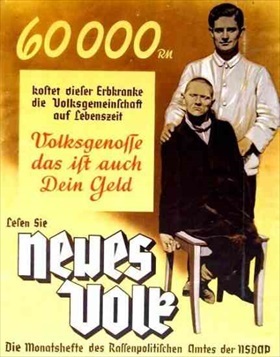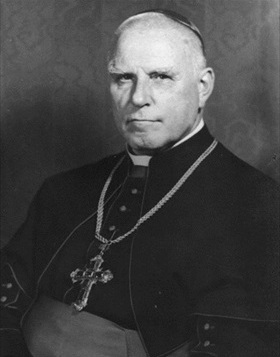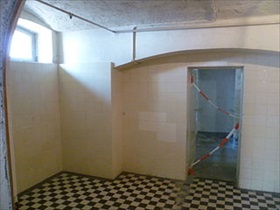CHURCH OUTCRY ENDS NAZI T-4 KILLING PROGRAM
Berlin, Germany · August 24, 1941
On this date in 1941 Adolf Hitler cancelled the Aktion T‑4 euthanasia program that he had personally put in place in September 1939. Normally Hitler had a policy of not issuing written instructions for policies relating to what would later be called crimes against humanity, but he made an exception when he provided written authority for the euthanasia program in a confidential October 1939 letter. In the months since its introduction, the euthanasia program, known as T‑4 after its Berlin address at Tiergartenstrasse 4, had provoked strong opposition from both the German public and influential church leaders, particularly the Bishop of Muenster, August von Galen. Von Galen’s sermons broke the secrecy that had hitherto surrounded the program, which he protested was unlawful by German and divine law (Fifth Commandment). Despite its cancellation, Aktion T‑4 operated unofficially until the end of the Nazi regime in 1945. The principal architect and co-director of the T-4 program was none other than Hitler’s personal physician, Karl Brandt. T‑4 physicians systematically killed those deemed “unworthy of life” (lebensunfaehig), including those considered “genetically inferior,” “racially deficient” (Jews, Slavs, and Gypsies), “maladjusted” (usually teenagers), and mentally or physically impaired. Even German civilians who suffered mental breakdowns after air raids were “selected for treatment.” As a result of the T-4 program, by the end of 1941 between 75,000 and 100,000 children and adults had been killed by lethal injection, starvation, or in gassing installations designed to look like shower stalls (a foretaste of Auschwitz and other death camps). Parents or relatives of those killed were typically informed that the cause of death was pneumonia or a similar ailment, and that the body had been cremated. Other bodies were secretly buried. Operation Barbarossa, the June 1941 invasion of the Soviet Union two months earlier, opened up rich new opportunities for newly displaced T‑4 personnel, and they soon set themselves up in the conquered eastern territories working on a vastly greater killing program: the “final solution of the Jewish question.” In the concentration and death camps in Poland, Brandt oversaw and participated in sadistic “medical experiments” on inmates. At the postwar Nuremberg trials, Brandt was the lead medical defendant. Unrepentant to the end, he was convicted and sentenced to hang, an act carried out on June 2, 1948.
[amazon_carousel widget_type=”ASINList” width=”600″ height=”200″ title=”Recommended Reading” market_place=”US” shuffle_products=”False” show_border=”False” asin=”0800629310,0195101065,1400033799,161145011X,0674745787,1591810329,0465049052,0801848245,1933718579,0547046847″ /]
Aktion T-4, the Nazis’ Euthanasia Program, 1939–1945
 |  |
Left: This circa 1938 poster reads: “60,000 Reichsmarks is what this person suffering from a hereditary defect costs our community during his lifetime. Fellow citizen, that is your money too. Read New People, the monthly magazine of the Office of Racial Policy of the NSDAP [National Socialist German Workers’ Party, or Nazi Party].” Many of the political initiatives of the Nazis arose from within the scientific community, and German medical journals openly discussed the need to find solutions to Germany’s Jewish and gypsy “problems” among others.
![]()
Right: “Lion of Münster,” Bishop Clemens August Graf von Galen. Politically conservative and a supporter of Nazi nationalism early on, Bishop von Galen came to decry Hitler’s persecution of the Catholic Church. He attempted to stop the Nazis’ euthanasia program, denouncing it from the pulpit in 1941. He also condemned Nazi deportations of Jews to the east. A sermon he gave in 1941 served as the inspiration for the anti-Nazi group “The White Rose,” and the sermon itself was the group’s first pamphlet. Von Galen suffered virtual house arrest from 1941 onwards. Although he did not participate in the July 1944 assassination attempt on Hitler’s life, the Nazis linked him to it, and he was subsequently imprisoned in Sachsenhausen concentration camp until its liberation. He died in 1946, the same year he was appointed cardinal by Pope Pius XII.
 |  |
Left: The Hartheim Euthanasia Center near Linz in Austria was one of six euthanasia institutes in the Third Reich. Over a period of 16 months between May 1940 and September 1, 1941, 18,269 people were killed at Hartheim. In all it is estimated that a total of 30,000 people were murdered there. Among them were the sick and the handicapped, as well prisoners from concentration camps too ill to work, such as those from nearby Mauthausen-Gusen. The killings were carried out using carbon monoxide poisoning.
![]()
Right: The German town of Hadamar in the state of Hessen housed a psychiatric clinic where 10,072 men, women, and children were asphyxiated with carbon monoxide in a gas chamber designed to look like a shower in the first phase of the T‑4 killing operations there (January to August 1941). Another 4,000 died through starvation and by lethal injection until March 1945. Hadamar citizens were aware of what was taking place at their clinic, especially since the cremation process was faulty. This often resulted in a cloud of stinking smoke hanging over the town. Local students would often taunt each other by saying “You’ll end up in the Hadamar ovens!”
Nuremberg Tribunal No. 1, November 1946: The United States of America vs. Karl Brandt and Twenty-Three Other Defendants (aka “The Medical Case”)
![]()

 History buffs, there is good news! The Daily Chronicles of World War II is now available as an ebook for $4.99 on Amazon.com. Containing a year’s worth of dated entries from this website, the ebook brings the story of this tumultuous era to life in a compelling, authoritative, and succinct manner. Featuring inventive navigation aids, the ebook enables readers to instantly move forward or backward by month and date to different dated entries. Simple and elegant! Click
History buffs, there is good news! The Daily Chronicles of World War II is now available as an ebook for $4.99 on Amazon.com. Containing a year’s worth of dated entries from this website, the ebook brings the story of this tumultuous era to life in a compelling, authoritative, and succinct manner. Featuring inventive navigation aids, the ebook enables readers to instantly move forward or backward by month and date to different dated entries. Simple and elegant! Click 











